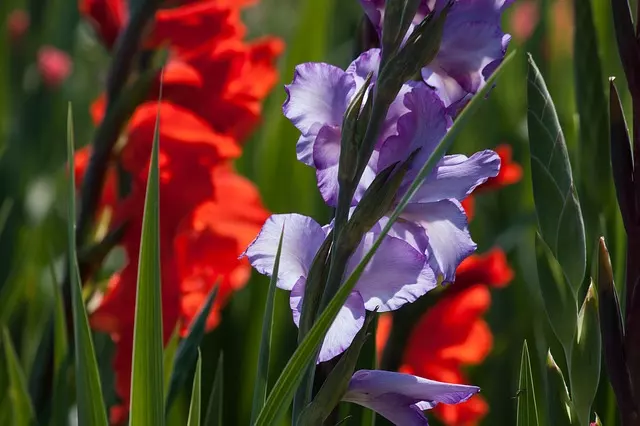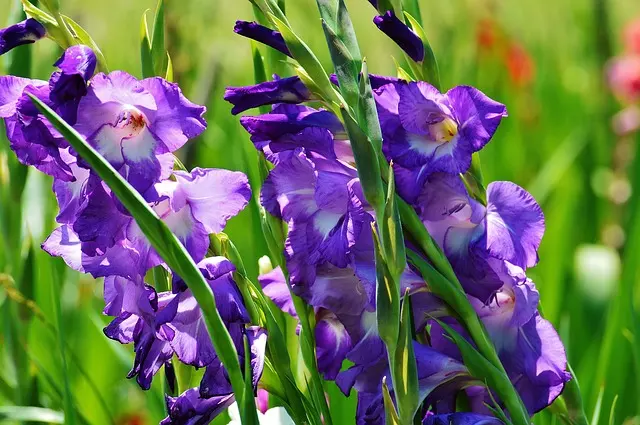The gladiolus is a typical spring bulb that blooms in summer. It is widely known as a garden flower, but undoubtedly where it is most commonly used is as a cut flower. In this article, we will explain how to plant gladiolus bulbs.
Within the gladiolus genus, we can find up to 250 different species of bulbs, mostly from the Mediterranean basin, Europe, Asia, tropical Africa, and South Africa.
Its use is so common and its flowers are so popular that professional gardeners have created an endless number of hybrid varieties of gladiolus, with large and small flowers, with a great variety of colors.
Table of Contents
Description of Gladiolus
Gladioli are produced from a corm, a thickened subway stem with a rounded and somewhat flattened shape. Therefore, although they are usually included among the spring “bulbs”, in reality, they are not.
They share many similarities with bulbs, such as their life cycle: they lose their aerial part during the winter season, keeping only their subway stem.
The stems of gladiolus can measure between 3.2 and 6.5 ft (1 and 2 meters) in height, covered with leaves at the bottom and being the support of the flowers. Its leaves are elongated and lanceolate.
They are sensitive to wind, so if they are not placed in a protected place in the garden, it is advisable to use plant support stakes to keep the flowering stem upright (Order stakes here).
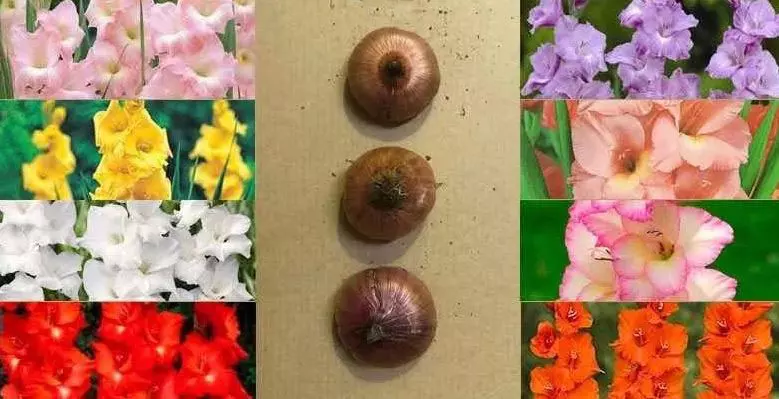
Flowering Gladiolus
The main attraction of gladiolus is its flowering. From the flower stalks usually appear between 12 to 20 flowers with spike formation.
The gladiolus blooms in a wide range of colors, such as red, maroon, pink, yellow, cream, there are even gladiolus flowers in green. You will find all these colors in a wide range of shades, from pastels to the most intense.
Its flowers also cover a good variety of sizes, fruit of the numerous crosses to which it has been subjected, being able to find miniature flowers to giants.
Classification of Gladiolus
Gladioli can be classified according to different parameters, such as their earliness, the size of their flowers, or their color.
According to their earliness. We have very early gladiolus, which will appear 68 to 70 days after planting, early, medium early, medium, medium late, late, and very late, which can take more than 100 days to bloom. With this variety of blooms, we can have gladiolus in successive bloom for more than a month.
Depending on the size of its flower. Large-flowered, with up to 7” (18 cm) and small flowers, from 1.5” to 3.1” (4 to 8 cm).
According to their color. White, red, pink, salmon, salmon, yellow gladioli, and more.
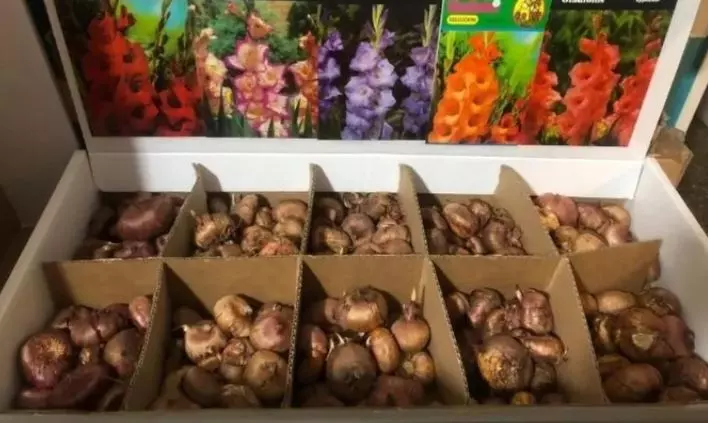
When Gladiolus Bloom
If we live in an area with a temperate climate (Mediterranean climate), the planting of gladiolus begins in late February and can be staggered until late August, to have flowers throughout the summer (Northern Hemisphere).
Depending on the variety, we have already seen that we can enjoy the first gladiolus flowers two months or so after sowing.
How to Plant Gladiolus Bulbs Step by Step
Follow these steps to learn how to plant gladiolus bulbs.
1- Planting depth should be about 2” to 2.7” (5 to 7 cm).
2- They are usually planted in rows, which can have a distance of about 10” (25 cm) between them, but between bulb and bulb space can be shortened to about 6” (15 cm).
3- For greater naturalness, it is convenient to plant small groups together, always in odd numbers.
4- If the variety planted has a tall stem and large flowers, it is a good idea to place a stake as soon as possible. In any case, we should look for a place protected from the wind or stake the bulbs.
5- It is advisable to spray the bulbs with fungicides before sowing to prevent the appearance of fungus.
6- Look for the bulb bud to be placed pointing upwards.
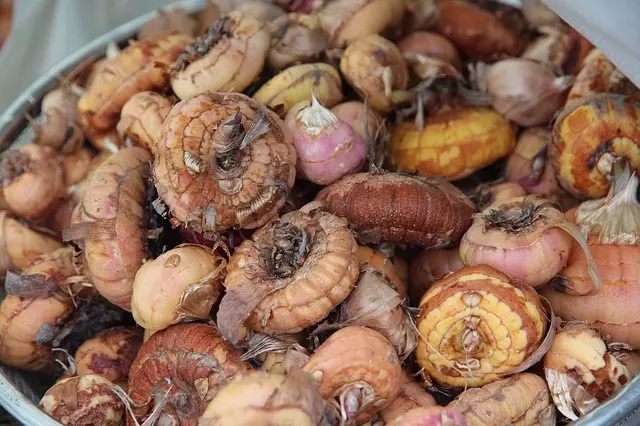
Gladiolus Care
Gladiolus is a perennial plant that is very easy to grow in the garden and propagates easily, so we will have gladiolus for many years to come.
How to Plant Gladiolus Bulbs – Sun Exposure
The gladiolus is a plant that needs imperatively to be in full sun to bloom, if we place the bulbs in the shade, it will not bloom.
This is not to say that they cannot thrive in semi-shade, as long as the hours of sunshine are sufficient and the temperature is right. They do not tolerate sweltering heat.
The optimum temperatures are between 50 to 59°F (10 to 15°C) at night and 68 to 77°F (20 to 25°C) during the day.
It is true that, if the heat is excessive, the flowers can last less time.
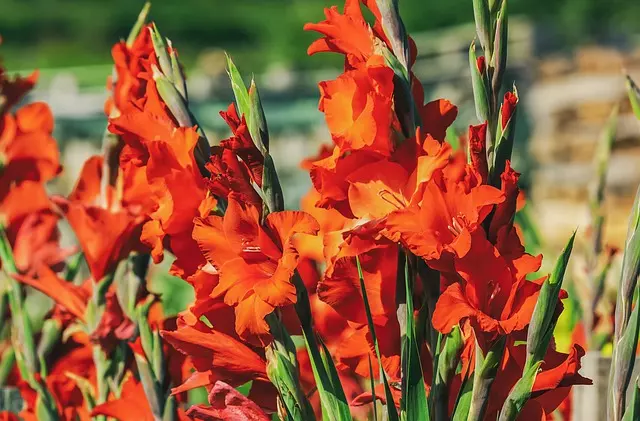
How to Plant Gladiolus Bulbs – Location
Gladiolus bulbs prefer loose, sandy soils that drain well so that waterlogging does not occur.
Although they thrive in some situations, it is best to provide them with soil rich in nutrients and organic matter that is not in direct contact with the bulbs.
A good idea is to prepare the soil in advance, during the fall or early winter, so that the compost is degraded when the bulbs are planted.
How to Plant Gladiolus Bulbs – Watering
They prefer relatively moist soils without waterlogging.
It is a good idea to water thoroughly at the beginning of planting, until the first buds begin to appear, from that moment on watering should be spaced to keep the soil moist, but without waterlogging.
It is not convenient that when it begins to bloom it is left without water since it could abort and not bloom.
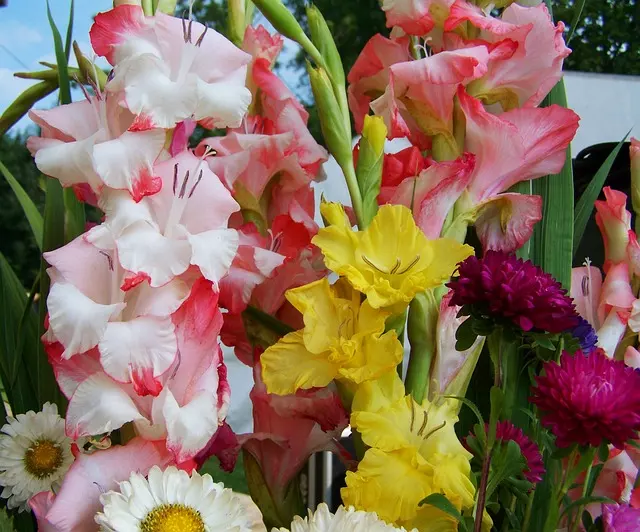
How to Plant Gladiolus Bulbs – Fertilizing
Fertilization should be done when the plant has already begun to grow, not before. A good rule of thumb is that they should be at least 6” (15 cm) high (Order fertilizer here).
It is not convenient to apply the fertilizer directly around the stem, it is better to do it at a distance of 4” or 5” (10 or 12 cm). If we use liquid fertilizers, they can be applied every three weeks, if, on the contrary, we use granulated fertilizers, a couple of times during its life cycle will be enough.
Diseases and Pests of Gladiolus
One of the most important pests in the cultivation of gladiolus is the appearance of the Fusarium fungus.
We can detect its appearance if we observe that the gladiolus leaves begin to yellow, the number of flowers is reduced and finally, the corms rot.
It is advisable to avoid fertilizers with ammoniacal nitrogen fertilizers, as they cause a certain acidity to the soil and favor its appearance.
Other common pests on gladiolus are thrips, aphids, and slugs, easily controlled with specific fungicides. We recommend using an organic fungicide (Order it here).
Home-made or ecological fungicides can also be used: potassium soap, nettle slurry.
Propagate Gladiolus
Gladioli propagate spontaneously.
Whenever we take out the gladiolus corms (bulbs) for storage, we can observe how around the bulbs there are other smaller bulbs, which we must separate and store separately, for the following season to plant and let it grow and thicken.
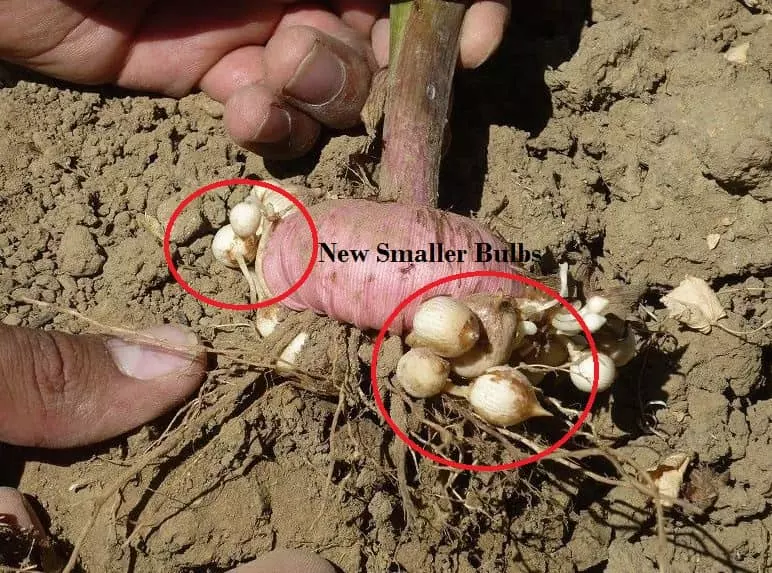
Storing Gladiolus Bulbs
Once gladiolus bulbs have flowered, it is wisest to dig them up for winter storage.
Only in warm, temperate climates can they be left in the ground, with the precaution of covering the surface over winter with mulch or straw to prevent damage from unexpected frost.
In areas where frosts are frequent, about six weeks after flowering the bulbs will be ready to be dug up. We will notice that their leaves turn yellow and begin to die.
Proceed as follows:
- Cut the stems to 0.4” (1 cm) from the bulb.
- Clean the bulbs well, removing all traces of soil with a soft brush.
- Let them dry for at least two weeks before storing them. It is advisable to look for a well-lit, airy, and warm place.
- Once they are dry, check that none of them have been hit or damaged in any way that could cause them to rot.
- Spray them with an insecticide before storing them definitively. They can be stored in paper bags or nets, separated by colors and varieties.
Frequently Asked Questions About the Gladiolus Plant
Are Gladiolus Deer Resistant?
Unfortunately, gladiolus is not a deer-resistant plant. You will need to protect it to prevent them from destroying it.
Can Gladiolus Grow in Pots?
It is possible to plant gladiolus bulbs in pots and have them grow perfectly. You just have to make sure that the pot is about 6” to 8” (15 to 20 cm) deep and to have a distance of 6” (15 cm) between bulb and bulb of gladiolus.
Can Gladiolus Grow in Shade?
Ideally, gladiolus bulbs should be planted in full sun. In the shade, they will grow with less strength and weaker color, so if possible, place them in full sun.
